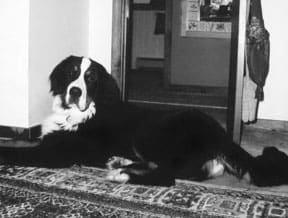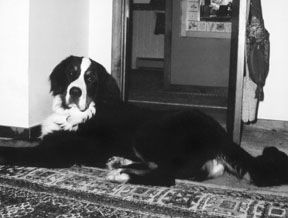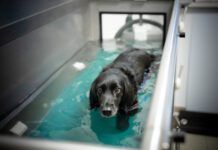[Updated January 30, 2019]
HOT SPOTS AND LICK GRANULOMAS: OVERVIEW
1. Treat hot spots with home remedies and lick granulomas with natural remedies that speed healing and tissue repair while clearing bacterial infections.
2. If necessary, keep your dog from licking and irritating the area by applying a bitter-tasting topical product or fitting the dog with an Elizabethan or cervical collar.
3. Help prevent future hot spot outbreaks by improving your dog’s diet and lifestyle.
Your dog has a weeping, oozing wound on her leg or a yucky red blob on the top of her head, and at first you wonder how she injured herself. But if you’ve been around the dog-care block, you realize that it isn’t a cut or scrape. That gooey mess might be diagnosed as pyotraumatic dermatitis, wet eczema, or a Staphylococcus intermedius infection, but it’s what everyone calls a hot spot.
Painful, irritating, swollen, and warm to the touch, hot spots can emit pus and smell awful. They can be triggered by bacteria, yeast, fungi, mange, fleas, irritating grooming products, swimming pool disinfectants, contaminated lakes or ponds, lawn-care products, or other environmental factors. Some dogs break out in hot spots weeks or months after being vaccinated. In many dogs, hot spots mark the return of seasonal allergies.

Most veterinarians treat hot spots after clipping and shaving fur around the lesion, a process that in severe cases can require sedation or the use of a local anesthetic. The area is washed with a disinfecting soap or rinsed with a liquid antiseptic. Astringents, anti-itch agents, antihistamines, hydrocortisone sprays or creams, drying agents, or antibiotics may be applied. In some cases topical treatment is accompanied by steroid injections or oral medication.
If the patient can’t leave a hot spot alone, she may have to wear an Elizabethan or cervical collar, which prevents the dog from biting, licking, or chewing the area while it heals.
Any dog can get a hot spot, especially those with heavy coats who live in humid climates. Sometimes swimming dogs get hot spots on their necks, which stay moist under collars. Dogs with a history of allergies, ear infections, anal sac irritations, or tangled hair mats are likely candidates. Breeds associated with hot spots include Labrador Retrievers, Golden Retrievers, St. Bernards, Bernese Mountain Dogs, Collies, and German Shepherds.
Lick Granulomas
Lick granulomas, officially known as acral lick dermatitis or ALD, occur when a dog licks excessively on a leg, paw, or other area, producing an itchy ulceration. Over time the licking forms a thick, hairless, red patch that may be accompanied by infection. Most lick granulomas are the size and shape of a silver dollar, but some extend for several inches in all directions.
A lick granuloma can result from an insect bite, cut, skin infection, imbedded foreign object, allergic dermatitis, arthritis pain, deep-seated fungal infections, external parasites like scabies and demodex, skin cancer lesion, or inflamed nerves or neuropathies, or it might begin for no apparent reason. In the last case, it’s considered a behavioral problem similar to human compulsions like nail biting. Psychological factors that contribute to compulsive licking often involve boredom, being crated for long periods, the addition of a new pet or person to the household, the death or loss of a companion animal, the absence of a family member, a move to a new house, or being boarded away from home.
The breeds most associated with ALD include Doberman Pinschers, Great Danes, Golden Retrievers, Labrador Retrievers, German Shepherds, Boxers, Dalmatians, English Setters, Shar Peis, and Weimaraners. In these breeds, allergy-related ALD is most likely to appear in middle age, when the dog is at least five years old. In many cases, symptoms coincide with seasonal allergies.
Anti-inflammatory drugs such as cortisone, antibiotics such as Cephalexin and Clavamox, laser therapy, antifungals, allergy shots, and psychoactive medications are conventional treatments for ALD. As with hot spots, an Elizabethan or cervical collar may be necessary to allow the wound to heal without being disturbed.
Finding the Cause of Hot Spots
Because conventional therapies can have serious side effects and because hot spots and lick granulomas are notorious for recurring, holistic veterinarians look beyond their obvious symptoms to their underlying causes.
Richard Pitcairn, DVM, PhD, author of Dr. Pitcairn’s Complete Guide to Natural Health for Dogs and Cats, disagrees with conventional veterinarians who diagnose various skin and coat problems as separate diseases. All skin and coat disorders, he says, are a single basic problem that manifests in individual animals depending on heredity, environment, nutrition, and other factors.
“One dog may have severely inflamed, moist, itchy hot spots near the base of his tail,” he explains, “while another may have thick, itchy skin along his back, with greasy, smelly secretions – but they are really the same health problem.”
According to Dr. Pitcairn, skin disorders stem from:
- Toxicity, most of it from poor-quality food and some from environmental pollutants or topically applied pest-control chemicals.
- Vaccinations, such as routinely administered multiple vaccines, which can induce immune disorders in susceptible animals.
- Suppressed disease, the remains of inadequately treated conditions that were never cured and which may cause periodic discharge through the skin.
- Psychological factors such as boredom, frustration, anger, and irritability. “As I see it,” he adds, “these are nearly always secondary issues that simply aggravate an already-exiting problem.”
What’s the cure? “It is possible to alleviate or even eliminate skin problems simply through fasting, proper nutrition, and the total health plan I describe in my book,” says Dr. Pitcairn. “It is surprising how much improvement can occur by these measures alone.”
He adds, “The most difficult conditions to treat are those previously dosed with lots of cortisone or its synthetic forms such as azium, depo, flucort, prednisone, or prednisolone. Corticosteroids effectively suppress symptoms like inflammation and itching, but they are in no sense curative.”
Fasting Your Dog Can Help Heal
The first step in Dr. Pitcairn’s treatment of hot spots, lick granulomas, and other skin problems is a short fast followed by an improved diet.
Juliette de Bairacli Levy recommends fasting for every canine illness. As she explains in her book, The Complete Herbal Handbook for the Dog and Cat, “During a fast, the body burns up fat deposits. As large amounts of body impurities are embedded in the fatty tissue of domestically reared dogs, the body begins to be cleansed deeply as stored fat is oxidized. Also the stomach and intestines, relieved of their usual tasks of dealing with food, can now concentrate on clearing away toxins.”
For skin conditions, Levy recommends feeding water only for two days, then water supplemented with honey, a tablespoon or two depending on the dog’s size, at mealtimes for an additional two days.
When it’s time to reintroduce food, consider switching from commercial pet food to a home-prepared diet, which is a simple, effective way to avoid processed grains, soy, chemical preservatives, artificial colors and flavors, synthetic vitamins, and other hard-to-digest or inferior-quality ingredients that can contribute to hot spots and skin irritations. If it’s not possible for an owner to feed her dog a home-prepared diet, upgrading the dog’s commercial food to a better-quality protein-based food may do the trick.
Another helpful strategy is to feed the dog once per day, removing food after 15 to 20 minutes, and omitting snacks and access to food dispensers. The canine digestive tract is designed for short feasts and long famines, not constant grazing.
For improved digestion and assimilation, try supplementing your dog’s food with an enzyme product such as Prozyme and/or Willard Water.
Adding Seacure, a predigested fish protein powder, is another way to speed tissue repair. Dee Eckert, the manufacturer’s director of operations, has received numerous reports from customers whose dogs recovered from hot spots and lick granulomas in record time. “Some of these dogs had lost over half their fur to hot spots,” she says, “but once they were put on Seacure, their sores healed quickly and their hair grew back.”
Topical Remedies for Treating Hot Spots
When it comes to topical remedies, holistic veterinarians, groomers, breeders, and owners have dozens of favorites. Here are a few.
EMT Gel, made from bovine collagen, stimulates and literally supports new cell growth by acting as a tissue adhesive while sealing and protecting hot spots, lick granulomas, and other injuries, including severe or deep wounds. The gel significantly reduces pain, bleeding, scarring, wound weeping, and the risk of infection. EMT gel comes in a tube. EMT Gel Spray is recommended for the treatment of scrapes, scratches, and other minor skin injuries, and it’s ideal for lick granulomas and hot spots because it contains a bitter, nontoxic ingredient that deters dogs from licking it off.
Another product mentioned in August’s wound healing article is the North American Tree Resin Company’s Hotspot/Livestock Formula, which contains highly antiseptic resin or pitch from coniferous trees. In addition to treating staph infections, cuts, fungal infections, and other wounds, pitch salve quickly repairs the damage caused by hot spots and lick granulomas.
The medium-chain fatty acids in coconut oil make it a skin-healer with antibacterial, antiviral, and antifungal properties. Coconut oil can be applied directly to hot spots, lick granulomas, boils, and other skin conditions, and is making a comeback in the diets of the health-conscious. Most dogs love the taste, so it’s easy to add to food.
The recommended maintenance dose is 1 teaspoon per 10 pounds of body weight. For topical application, it can be made less appetizing with a top layer of grapefruit seed extract, which has a bitter taste, or a tablespoon of coconut oil can be mixed with 10 to 15 drops of any skin-healing essential oil that has a medicinal odor.
Willard Water is a concentrate added to water for enhanced healing benefits. Wendy Volhard, author of Holistic Guide for the Healthy Dog, applies a dilute solution of Willard Water to hot spots as soon as they appear. “It dries up the inflamed areas overnight,” she says.

Cortney Rice of New City, New York, used Willard Water on her six-year-old Rottweiler, Kalle, who had a two-inch-wide hot spot on her inner left leg, just below the knee joint. “It was red, oozing, sometimes bleeding, and very warm to the touch,” Rice describes. “It did not respond to Pramoxine HCl, which our veterinarian prescribed. I diluted a teaspoon of Willard Water concentrate with 8 ounces water and sprayed it twice a day, thoroughly soaking the hot spot and the area around it. By the second day, the hot spot had dramatically dried up and the skin was cool again. Kalle hasn’t licked her knee since the first application, plus she loves getting sprayed with it. I have continued this treatment for six days now, and her skin looks great.”
Herbs and Aromatherapy for Hot Spot Treatment
Hot spots and eczema, says Juliette de Bairacli Levy, are often nature’s way of ridding the body of accumulated toxins from commercial pet foods and/or a lack of exercise. She treats hot spots and lick granulomas with fasting, natural diet, and medicinal herbs, adding her own herbal antiseptic tablets to the dog’s food to speed healing from within.
Vermont herbalist Rosemary Gladstar has followed Levy’s nutritional recommendations for all of her Bernese Mountain Dogs, including Deva, who arrived with mange and large, bald, weeping hot spots.
“Having shared my life with a breed that’s prone to hot spots, I have a lot of experience,” Gladstar says. “In addition to fasting dogs and putting them on a natural diet, I apply powdered goldenseal (Hydrastic canadensis) to the hot spot. It will stick, especially if there is that awful ooze, or you can mix it with aloe vera gel, comfrey (Symphytum officinale) tea, or powdered comfrey and aloe vera to make a paste that heals the sore. Thanks to her natural diet and herbal first aid, Deva, who is now nine years old, continues to thrive, and her coat looks terrific.”
Aromatherapy’s essential oils and hydrosols offer many effective ingredients for the treatment of hot spots and lick granulomas. As WDJ has explained in the past, essential oils and hydrosols (“flower waters” produced during steam distillation) have significant healing properties, as do the carrier or base oils in which essential oils can be diluted for safe, effective pet application. Hydrosols of any of the plants mentioned here can be applied full-strength to hot spots and lick granulomas.
Lavender (Lavandula angustifolia), helichrysum, also known as immortelle or everlasting (Helichrysum italicum), and carrot seed (Daucus carota) essential oils are famous for their skin-healing properties. Palmarosa (Cymbopogon martinii) and sweet marjoram (Origanum marjorana) essential oils heal the skin while relieving stress. Peppermint (Mentha piperita) essential oil relieves pain and itching while stimulating circulation and healing. German chamomile (Matricaria recutita), Roman chamomile (Anthemis nobilis), frankincense (Boswelia carteri), and myrrh (Commiphora myrrha) essential oils reduce pain, itching, and irritation. Juniper berry (Juniperus communis) essential oil is recommended for eczema and hair loss.
Kristen Leigh Bell, author of Holistic Aromatherapy for Animals, recommends labdunum or rock rose (Cistus ladaniferus) essential oil in wound care blends because of its antibacterial, astringent properties. She also uses niaoili (Melaleuca quinquenervia veridiflora, or MQV) essential oil for any type of allergy manifesting itself in the skin. MQV oil is related to tea tree oil but has a more pleasing scent along with powerful antibacterial and antihistamine effects.
Unrefined sea salt helps heal wounds of every description, and when essential oils are added to sea salt and water, the result is a highly effective hot spot spray or wash. To a glass jar containing 1 cup of unrefined sea salt or kosher salt, add ½ teaspoon (30 drops) of any of the essential oils mentioned here, in any combination. Close tightly, then shake and rotate the jar to mix well. Store in a cool, dark place. When needed, dissolve 1 tablespoon of the salt in ¼ cup cool water. Shake or stir to dissolve. Spray on hot spots and lick granulomas, or saturate cotton and apply three or four times per day.
Ten to 15 drops of essential oil in a tablespoon (½ fluid ounce) of carrier oil is another effective treatment for these conditions. Calophyllum or tamanu oil (Calophyllum inophyllum) is one of the most prized carrier or base oils for the healing of wounds, eczema, and other skin conditions. Coconut oil, rose hip seed oil (Rosa mosquette, R. rubiginosa), and kukui nut oil (Aleurites moluccana) are other effective carrier oils renowned for their ability to fight infection, stimulate cell growth, and reduce or prevent scarring.
Years ago, Colorado aromatherapist Frances Fitzgerald Cleveland was out of town when her dog, Jake, developed a hot spot. The steroid shot he received caused kidney failure and Jake died. In his memory, Cleveland blended Jake’s Remedy, which contains purified water, apricot kernel oil, and a proprietary blend of essential oils. Oscar, Cleveland’s seven-year-old black Labrador Retriever, swims every day, gets sprayed every day, and has never had skin problems.
Shelley Voorhees of Littleton, Colorado, reports that her champion Rottweiler was a blood donor in 2000. “He had a severe reaction to the scrub that was used, and he developed a hot spot that covered his neck and chest,” she says. “After a course of antibiotics, the hot spot was still very inflamed and still oozing. I tried Jake’s Remedy, and within 48 hours the oozing stopped. The hot spot healed within a week and his hair quickly grew back.”
At AromaDog, Faith Thanas combines essential oils with rosehip seed, jojoba, and evening primrose oils to make Hot Spot Anti-Inflammatory, a healing blend that calms and soothes.
“It’s been tested over and over with great results,” she says. “Rose geranium balances the system, repairs capillaries, regenerates cells, and heals wounds. Rosewood is a cellular stimulant. Pine is anti-infectious and good for sores and eczema. Helichrysum and lavender are an extremely healing combination, especially for open wounds. This product also contains Rescue Remedy, the Bach Flower Remedy blend that supports dogs in all types of emergencies.”
In Hollywood, Florida, Paul Funt’s American Bulldog, Diesel, had two very large hot spots on his head and face. “Both were extremely irritated and infected,” he says. “I tried several herbs sent by my homeopath and finally gave up. Then Diesel saw a doctor who sent him home with AromaDog’s Hot Spot remedy, which I applied twice daily. Within two days, the hot spots were almost completely healed, and after five days they were gone.”
Kansas aromatherapist Joan Clark developed Hot Spot Mist with the essential oils of blue chamomile, lavender, helichrysum, and tea tree in a base of fractionated coconut oil, callophyllum oil, jojoba, borage seed oil, aloe vera, and St. John’s wort.
“My success stories include my own dog, Sabrina,” she says. “She got a hot spot on her neck, and as soon as I noticed it I used the Hot Spot Mist along with lavender hydrosol to keep drying it out. It disappeared in less than 48 hours and left a nice healthy scab.”
Additional Therapies for Hot Spots and Lick Granulomas
Physical symptoms are easy to address, but conditions like obsessive-compulsive disorders, boredom, frustration, and anxiety are more challenging.
Obviously, it can make a difference to give a bored dog something interesting to do, an anxious dog the reassurance of a stable, predictable routine and positive training, and a frustrated dog plenty of interesting outdoor exercise. Any dog can be treated with energy-balancing techniques like Tellington TTouch, massage, Reiki, acupuncture, and nutrition.
Flower remedies, also called flower essences, can help, too. Kris Lecakes Haley, a Bach Flower Remedy practitioner in Arizona, has found that white chestnut and chestnut bud flower remedies effectively address repetitive chewing and licking, while crab apple and beech help with allergy-driven skin eruptions.
In Bach Flower Remedies for Animals, Helen Graham and Gregory Vlamis recommend walnut for eruptive conditions like hot spots and agrimony for anxiety that manifests in skin conditions. Flower remedies work best when diluted with water and applied frequently to the mouth, ears, nose, abdomen, and paw pads or sprayed in the air near the dog.
With the help of improved nutrition, effective topical treatments, rewarding routines, active outdoor exercise, and emotional support, any dog can enjoy a happy, healthy life free from hot spots, lick granulomas, and other skin problems.
A long-time contributor to WDJ and author of The Encyclopedia of Natural Pet Care, Natural Remedies for Dogs and Cats, and other books, CJ Puotinen lives in New York with her husband, a Lab, and a tabby cat.







I have two beautiful male shih tzu’s they are brothers, they each have allergies driven skin eruptions -they lick constantly, all of the vet. medicine help temportary – and I’ve spent hundreds of dollars at the Vet. I was attempting to make another Vet. appointment this morning , I was researching information about the EMT Gel and came upon these articiles – I was startle – and so relieved to find help. Thank you – I’m more than sure that my two babies will be well very soon, because I’m preparing right now to began the new treatment of oils, water, and fasting for my babies and myself. Thank you.
My dog only started this a week ago and it’s horrible, and spreading. He was attacked by a pitbull the week before. Is there any chance it could be something worse, or is it simply a psychological reaction that can be treated without seeing a vet? The dog almost tore off his ear and bit a hole in his chest and the scruff of his neck. He’s been vaccinated and has his rabies shots so I didn’t take him in, do I need to now, is it something much worse? My dad just came home and is still recovering from the coronavirus so we’re quarantined and this behavior started the day after my dad returned. Please someone advise!!